Excellent Wear Resistance of a High-Speed Train Brake Disc Steel with High Hardening Ratcheting Strain Zone
Abstract
:1. Introduction
2. Materials and Methods
2.1. Test Steel
2.2. Microstructural Characterization
2.3. Dry Rolling–Sliding Wear Test
2.4. Micron Scratch Test
3. Results and Discussion
3.1. Wear Resistance
3.2. Microstructure Analysis
3.2.1. Matrix Microstructure
3.2.2. Definition of Ratcheting Strain Zone
3.2.3. Shear Strain Distribution
3.2.4. Martensite Lath Characteristics
3.2.5. Dislocation Density Analysis
3.3. Distribution of Hardness and Fracture Toughness in Ratcheting Strain Zone
3.4. Discussion of Wear Resistance under Rolling–Sliding
4. Conclusions
- (1)
- A ratcheting strain zone with gradient structure and high-density dislocation was formed at the surface of the experimental steel during the rolling–sliding wear process. The equivalent shear strain decreased with the increase of depth until stabilized in the matrix. The microstructure at the topmost surface underwent refinement, and the martensite lath was crushed into nano/sub-micron grain and strip.
- (2)
- The continuous change of the hardness and toughness of the RS zone could be well evaluated by a micron scratch test. The topmost surface layer possessed the highest hardening rate of ~1.7 but lost 67% of fracture toughness compared to the matrix.
- (3)
- Compared to other wear-resistant iron and steel materials used for railway, the test steel exhibited one of the lowest specific wear rates under similar wear test due to the higher hardening rate caused by the high-density dislocation and grain refinement in the ratcheting stain zone.
Author Contributions
Funding
Institutional Review Board Statement
Informed Consent Statement
Data Availability Statement
Conflicts of Interest
References
- Zhai, W.; Bai, L.; Zhou, R.; Fan, X.; Kang, G.; Liu, Y.; Zhou, K. Recent Progress on Wear-Resistant Materials: Designs, Properties, and Applications. Adv. Sci. 2021, 8, 2003739. [Google Scholar] [CrossRef] [PubMed]
- Givoni, M. Development and Impact of the Modern High-speed Train: A Review. Transp. Rev. 2006, 26, 593–611. [Google Scholar] [CrossRef]
- Aulia Putra, M.R.; Pratama, P.S.; Prabowo, A.R. Failure of Friction Brake Components against Rapid Braking Process: A Review on Potential Challenges and Developments. Transp. Res. Procedia 2021, 55, 653–660. [Google Scholar] [CrossRef]
- Mazzù, A.; Provezza, L.; Zani, N.; Petrogalli, C.; Ghidini, A.; Faccoli, M. Effect of shoe braking on wear and fatigue damage of various railway wheel steels for high speed applications. Wear 2019, 434–435, 203005. [Google Scholar] [CrossRef]
- Faccoli, M.; Provezza, L.; Petrogalli, C.; Ghidini, A.; Mazzù, A. Effects of full-stops on shoe-braked railway wheel wear damage. Wear 2019, 428–429, 64–75. [Google Scholar] [CrossRef]
- Xiao, X.; Yin, Y.; Bao, J.; Lu, L.; Feng, X. Review on the friction and wear of brake materials. Adv. Mech. Eng. 2016, 8, 1687814016647300. [Google Scholar] [CrossRef] [Green Version]
- Kumar, A.; Saxena, A.K.; Kirchlechner, C.; Herbig, M.; Brinckmann, S.; Petrov, R.H.; Sietsma, J. In situ study on fracture behaviour of white etching layers formed on rails. Acta Mater. 2019, 180, 60–72. [Google Scholar] [CrossRef]
- Jalalahmadi, B.; Slack, T.; Raje, N.; Arakere, N.; Feng, J.; Wan, Z.; Wang, W.; Ding, X.; Tang, Y. A Review of Rolling Contact Fatigue. J. Tribol. 2009, 131, 308. [Google Scholar] [CrossRef]
- El Laithy, M.; Wang, L.; Harvey, T.J.; Vierneusel, B.; Correns, M.; Blass, T. Further understanding of rolling contact fatigue in rolling element bearings—A review. Tribol. Int. 2019, 140, 105849. [Google Scholar] [CrossRef]
- He, C.G.; Ding, H.H.; Shi, L.B.; Guo, J.; Meli, E.; Liu, Q.Y.; Rindi, A.; Zhou, Z.R.; Wang, W.J. On the microstructure evolution and nanocrystalline formation of pearlitic wheel material in a rolling-sliding contact. Mater. Charact. 2020, 164, 110333. [Google Scholar] [CrossRef]
- Ezzati, M.; Naghipour, M.; Zeinoddini, M.; Zandi, A.P.; Elyasi, M. Strain ratcheting failure of dented steel submarine pipes under combined internal pressure and asymmetric inelastic cycling. Ocean Eng. 2021, 219, 108336. [Google Scholar] [CrossRef]
- Zhao, X.J.; Guo, L.C.; Guo, J.; Liu, Q.Y.; Butini, E.; Marini, L.; Meli, E.; Rindi, A.; Wang, W.J. Effect of spherical and ballast dents on rolling contact fatigue of rail materials. Wear 2020, 450–451, 203254. [Google Scholar] [CrossRef]
- Wang, W.; Liu, H.; Zhu, C.; Wei, P.; Wu, W. Micromechanical analysis of gear fatigue-ratcheting damage considering the phase state and inclusion. Tribol. Int. 2019, 136, 182–195. [Google Scholar] [CrossRef]
- Donzella, G.; Faccoli, M.; Mazzù, A.; Petrogalli, C.; Roberti, R. Progressive damage assessment in the near-surface layer of railway wheel-rail couple under cyclic contact. Wear 2011, 271, 408–416. [Google Scholar] [CrossRef]
- Mazzù, A.; Donzella, G. A model for predicting plastic strain and surface cracks at steady-state wear and ratcheting regime. Wear 2018, 400–401, 127–136. [Google Scholar] [CrossRef]
- Athukorala, A.C.; De Pellegrin, D.V.; Kourousis, K.I. A unified material model to predict ratcheting response in head-hardened rail steel due to non-uniform hardness distributions. Tribol. Int. 2017, 111, 26–38. [Google Scholar] [CrossRef] [Green Version]
- Ohno, N.; Nakamoto, H.; Morimatsu, Y.; Okumura, D. Modeling of cyclic hardening and evaluation of plastic strain range in the presence of pre-loading and ratcheting. Int. J. Plast. 2021, 145, 103074. [Google Scholar] [CrossRef]
- Dutta, K.; Kishor, R.; Sahu, L.; Mondal, A.K. On the role of dislocation characters influencing ratcheting deformation of austenitic stainless steel. Mater. Sci. Eng. A 2016, 660, 47–51. [Google Scholar] [CrossRef]
- Kumar, A.; Agarwal, G.; Petrov, R.; Goto, S.; Sietsma, J.; Herbig, M. Microstructural evolution of white and brown etching layers in pearlitic rail steels. Acta Mater. 2019, 171, 48–64. [Google Scholar] [CrossRef]
- Hajizad, O.; Kumar, A.; Li, Z.; Petrov, R.H.; Sietsma, J.; Dollevoet, R. Influence of Microstructure on Mechanical Properties of Bainitic Steels in Railway Applications. Metals 2019, 9, 778. [Google Scholar] [CrossRef] [Green Version]
- Moslemi, N.; Mozafari, F.; Abdi, B.; Gohari, S.; Redzuan, N.; Burvill, C.; Ayob, A. Uniaxial and biaxial ratcheting behavior of pressurized AISI 316L pipe under cyclic loading: Experiment and simulation. Int. J. Mech. Sci. 2020, 179, 105693. [Google Scholar] [CrossRef]
- Kong, W.; Zhang, D.; Tao, Q.; Chen, K.; Wang, J.; Wang, S. Wear properties of the deep gradient wear-resistant layer applied to 20CrMnTi gear steel. Wear 2019, 424–425, 216–222. [Google Scholar] [CrossRef]
- Zhou, Y.; Peng, J.F.; Luo, Z.P.; Cao, B.B.; Jin, X.S.; Zhu, M.H. Phase and microstructural evolution in white etching layer of a pearlitic steel during rolling–sliding friction. Wear 2016, 362–363, 8–17. [Google Scholar] [CrossRef]
- Zhao, H.; Liu, P.; Ding, Y.; Jiang, B.; Liu, X.; Zhang, M.; Chen, G. An Investigation on Wear Behavior of ER8 and SSW-Q3R Wheel Steel under Pure Rolling Condition. Metals 2020, 10, 513. [Google Scholar] [CrossRef] [Green Version]
- Tsybenko, H.; Farzam, F.; Dehm, G.; Brinckmann, S. Scratch hardness at a small scale: Experimental methods and correlation to nanoindentation hardness. Tribol. Int. 2021, 163, 107168. [Google Scholar] [CrossRef]
- Liu, M.; Li, S.; Gao, C. Fracture Toughness Measurement by Micro-Scratch Tests with Conical Indenter. Mocaxue Xuebao/Tribol. 2019, 39, 556–564. [Google Scholar] [CrossRef]
- YB/T. YB/T5345-2014 Rolling Contact Fatigue Test Method for Metal Materials. Metall. Ind. Press Beijing 2014, 1–23. Available online: http://www.cssn.net.cn/cssn/front/85213526.html (accessed on 20 June 2021).
- Dautzenberg, J.H.; Zaat, J.H. Quantitative determination of deformation by sliding wear. Wear 1973, 23, 9–19. [Google Scholar] [CrossRef] [Green Version]
- Alpas, A.T.; Hu, H.; Zhang, J. Plastic deformation and damage accumulation below the worn surfaces. Wear 1993, 162–164, 188–195. [Google Scholar] [CrossRef]
- Yin, C.-h.; Liang, Y.-l.; Jiang, Y.; Yang, M.; Long, S.-l. Formation of nano-laminated structures in a dry sliding wear-induced layer under different wear mechanisms of 20CrNi2Mo steel. Appl. Surf. Sci. 2017, 423, 305–313. [Google Scholar] [CrossRef]
- Hansen, N.; Mehl, R.; Su, H.; Pun, C.L.; Mutton, P.; Kan, Q.; Kang, G.; Yan, W. New discoveries in deformed metals. Metall. Mater. Trans. A 2001, 32, 2917–2935. [Google Scholar] [CrossRef]
- Yin, C.-H.; Liang, Y.-l.; Liang, Y.; Li, W.; Yang, M. Formation of a self-lubricating layer by oxidation and solid-state amorphization of nano-lamellar microstructures during dry sliding wear tests. Acta Mater. 2019, 166, 208–220. [Google Scholar] [CrossRef]
- Mukhopadhyay, D. Identifying the causes of residual stress in polycrystalline diamond compact (PDC) cutters by X-Ray diffraction technique. Results Mater. 2021, 11, 100216. [Google Scholar] [CrossRef]
- Williamson, G.K.; Hall, W.H. X-ray line broadening from filed aluminium and wolfram. Acta Metall. 1953, 1, 22–31. [Google Scholar] [CrossRef]
- Wilkens, M.; Paul, S.K.; Stanford, N.; Taylor, A.; Hilditch, T. The Determination of Density and Distribution of Dislocations in Deformed Single Crystals from Broadened X-ray Diffraction Profiles. Phys. Status Solidi (A) 1970, 2, 359–370. [Google Scholar] [CrossRef]
- Das Bakshi, S.; Sinha, D.; Ghosh Chowdhury, S. Anisotropic broadening of XRD peaks of α′-Fe: Williamson-Hall and Warren-Averbach analysis using full width at half maximum (FWHM) and integral breadth (IB). Mater. Charact. 2018, 142, 144–153. [Google Scholar] [CrossRef]
- Das Bakshi, S. Wear of Fine Pearlite, Nanostructured Bainite and Martensite; University of Cambridge: Cambridge, UK, 2017. [Google Scholar]
- Das Bakshi, S.; Sinha, D.; Ghosh Chowdhury, S.; Mahashabde, V.V. Surface and sub-surface damage of 0.20 wt% C-martensite during three-body abrasion. Wear 2018, 394–395, 217–227. [Google Scholar] [CrossRef]
- Dong, Y.; Kang, G.; Liu, Y.; Wang, H.; Cheng, X. Dislocation evolution in 316L stainless steel during multiaxial ratchetting deformation. Mater. Charact. 2012, 65, 62–72. [Google Scholar] [CrossRef]
- Zhao, H.; Zhong, Y.; Ma, Z. Effects of indentation depth on micro hardness and scratch behavior of thin composite laminate. J. Alloy. Compd. 2016, 680, 105–108. [Google Scholar] [CrossRef]
- ASTM. ASTM G171 Standard Test Method for Scratch Hardness of Materials Using a Diamond Stylus. ASTM Stand 2009, 3, 1–7. Available online: https://www.astm.org/Standards/G171.html (accessed on 20 June 2021).
- Zhou, T.; Zhao, H.; Zhou, H.; He, Y.; Zhang, M.; Su, S. Influences of microstructure on rolling-slip contact fatigue wear properties of high-speed wheel steel. J. Mater. Heat Treat. 2020, 41, 110–117. [Google Scholar] [CrossRef]
- Hasan, S.M.; Chakrabarti, D.; Singh, S.B. Dry rolling/sliding wear behaviour of pearlitic rail and newly developed carbide-free bainitic rail steels. Wear 2018, 408–409, 151–159. [Google Scholar] [CrossRef]
- Liu, J.P.; Li, Y.Q.; Zhou, Q.Y.; Zhang, Y.H.; Hu, Y.; Shi, L.B.; Wang, W.J.; Liu, F.S.; Zhou, S.B.; Tian, C.H. New insight into the dry rolling-sliding wear mechanism of carbide-free bainitic and pearlitic steel. Wear 2019, 432–433, 202943. [Google Scholar] [CrossRef]
- Xu, L.; Fan, X.; Wei, S.; Liu, D.; Zhou, H.; Zhang, G.; Zhou, Y. Microstructure and wear properties of high-speed steel with high molybdenum content under rolling-sliding wear. Tribol. Int. 2017, 116, 39–46. [Google Scholar] [CrossRef]
- Rigney, D.A. The roles of hardness in the sliding behavior of materials. Wear 1994, 175, 63–69. [Google Scholar] [CrossRef]
- Hu, Y.; Guo, L.C.; Maiorino, M.; Liu, J.P.; Ding, H.H.; Lewis, R.; Meli, E.; Rindi, A.; Liu, Q.Y.; Wang, W.J. Comparison of wear and rolling contact fatigue behaviours of bainitic and pearlitic rails under various rolling-sliding conditions. Wear 2020, 460–461, 203455. [Google Scholar] [CrossRef]
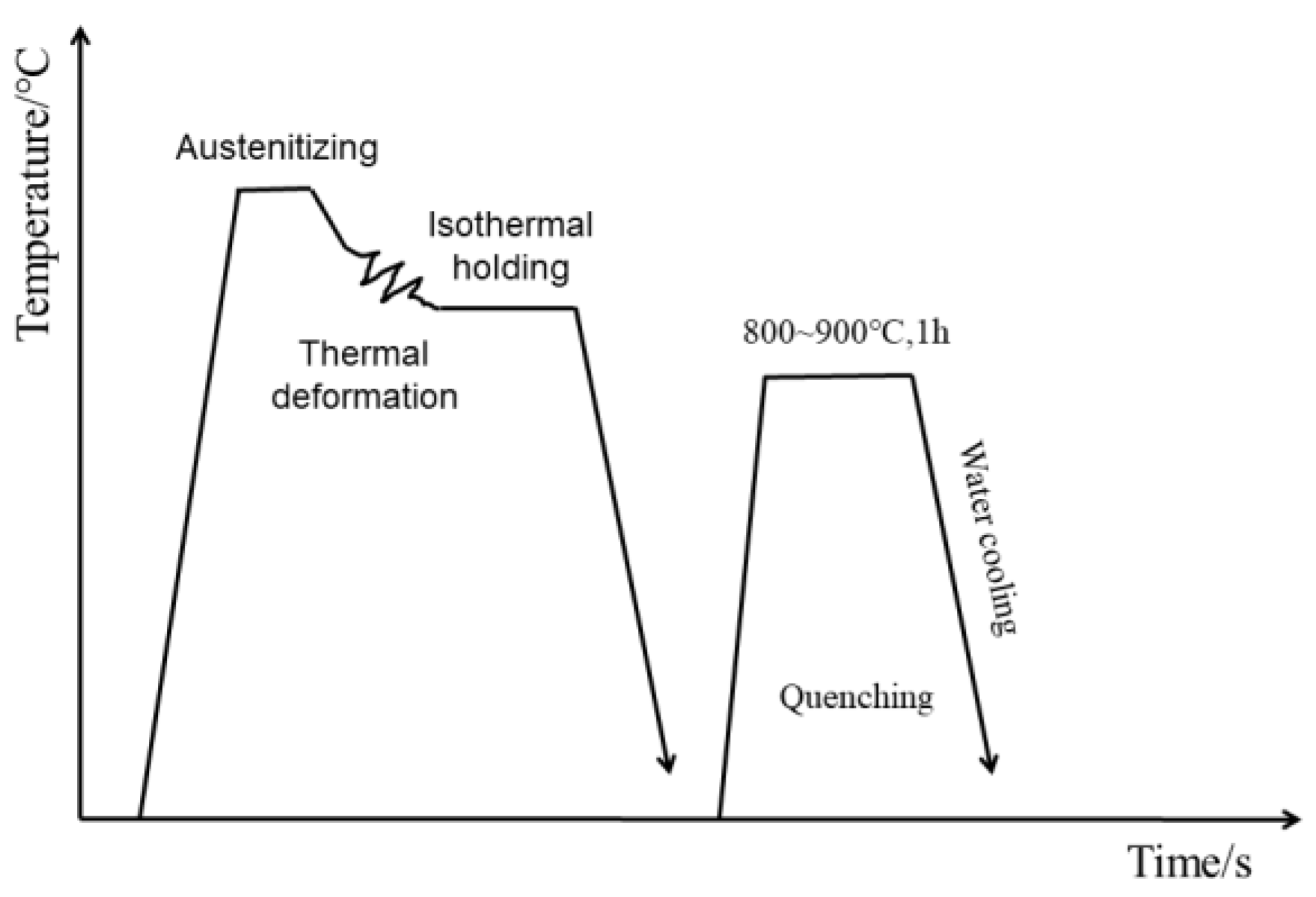

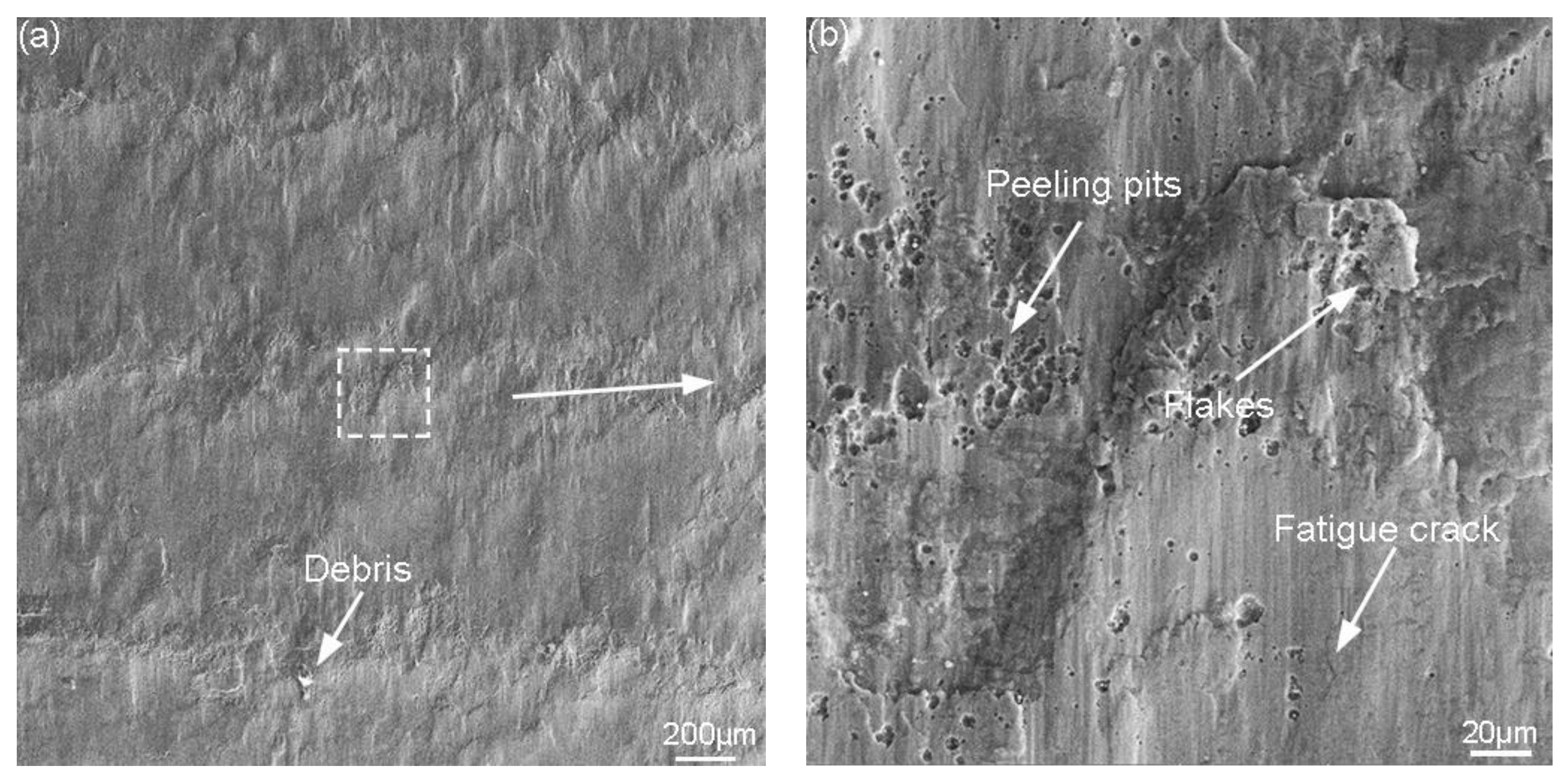
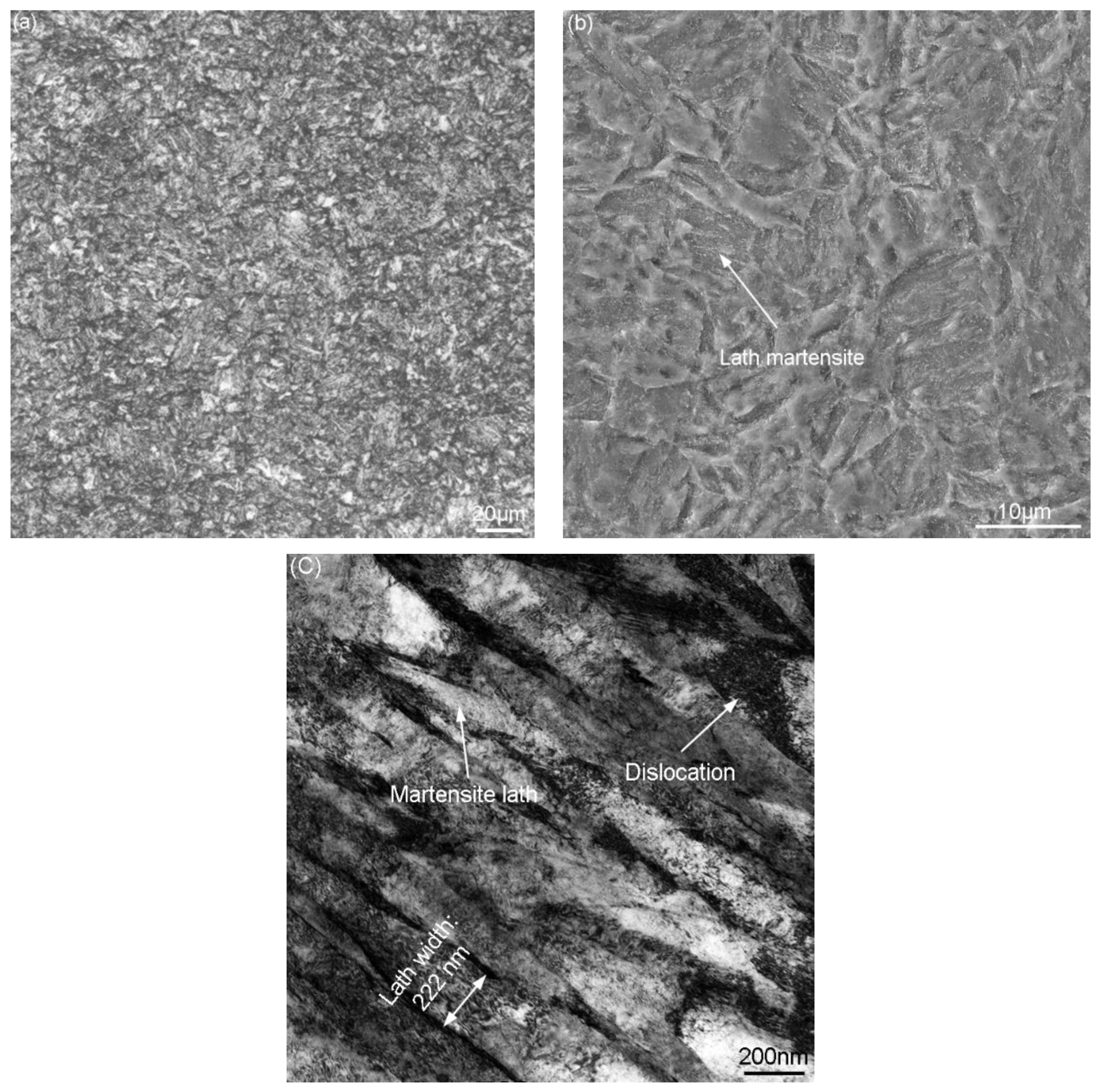




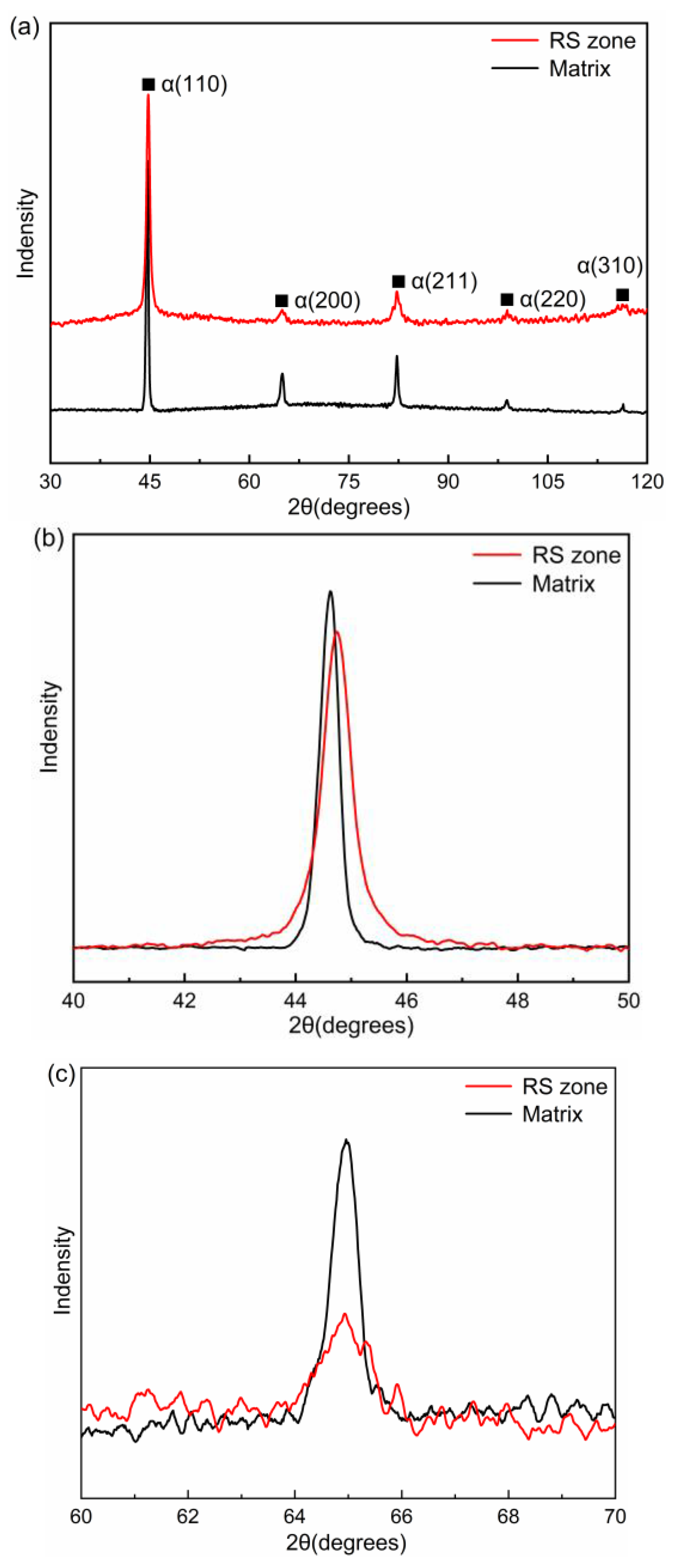
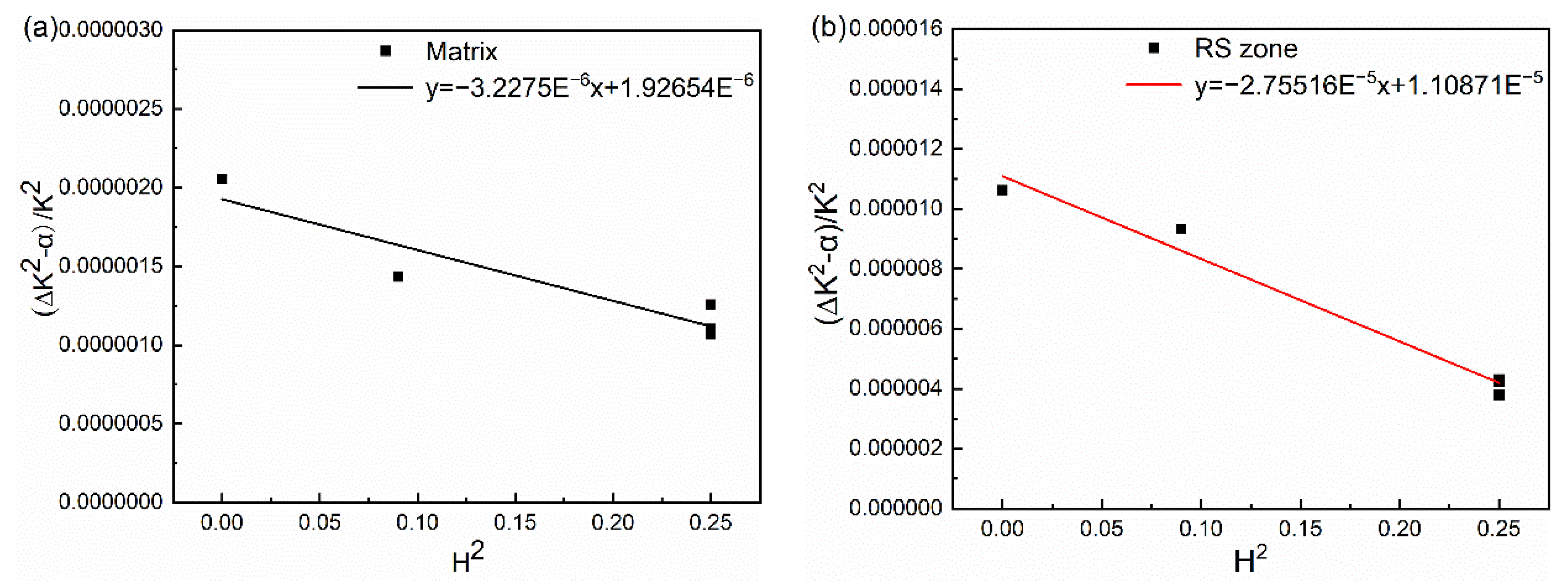

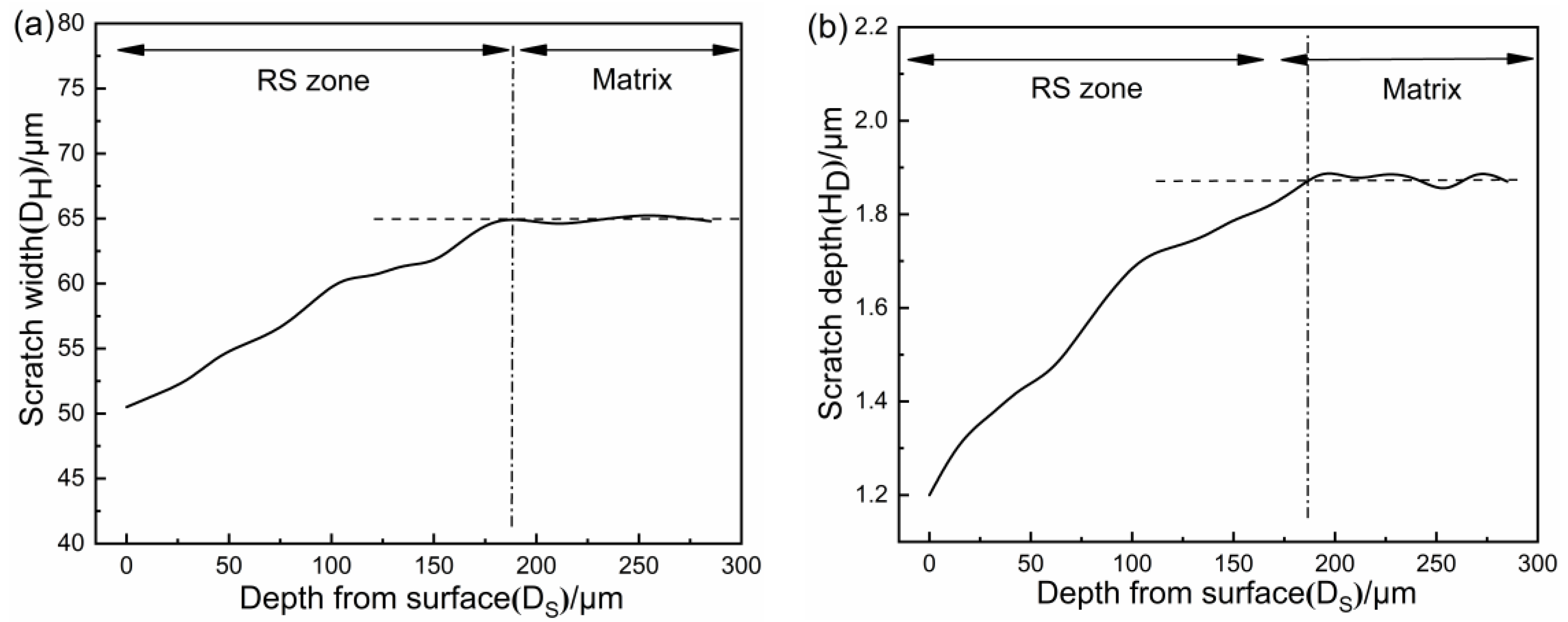

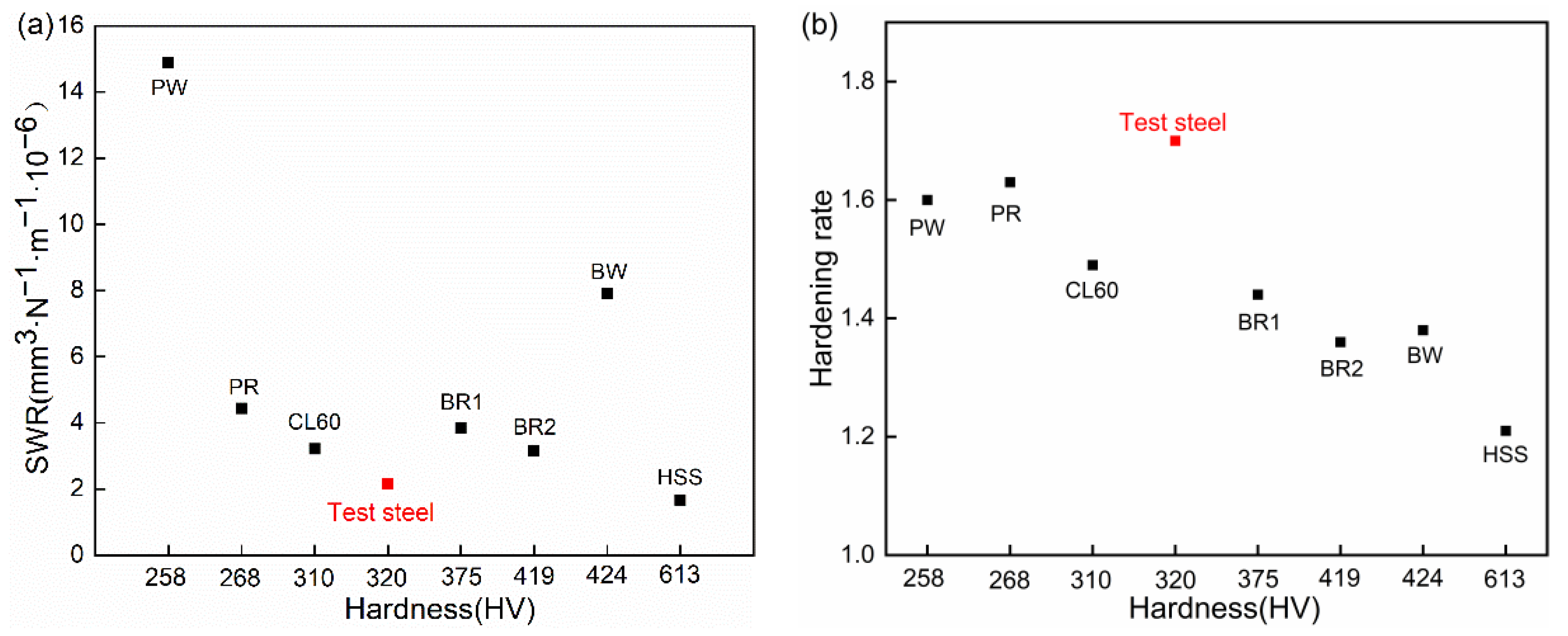
| C | Si | Mn | Cr | Ni | Mo | V |
|---|---|---|---|---|---|---|
| 0.20~0.22 | 0.40~0.42 | 1.10~1.12 | 0.90~0.94 | 0.98~1.00 | 0.64~0.66 | 0.06~0.08 |
| Yield Strength/MPa | Tensile Strength/MPa | Elongation/% | Microhardness/HV |
|---|---|---|---|
| 1030 | 1250 | 9 | 320 |
| cosτ | αβ | F/N | Slide Ratio/% | RPM/r·min−1 | T/s | ||
|---|---|---|---|---|---|---|---|
| 0.171 | 0.166 | 1.01 | 800 | 10 | 400 | 2414 | 0.15 |
| Material | Mass before Wear/g | Mass after Wear/g | Wear Loss/g | SWR/mm3∙m−1∙N−1 |
|---|---|---|---|---|
| Test steel | 77.6341 | 77.6087 | 0.0254 | 2.69 × 10−6 |
| Sample | FWHM/(°) | ||||
|---|---|---|---|---|---|
| (110) | (200) | (211) | (220) | (311) | |
| Matrix | 0.316 | 0.573 | 0.514 | 0.584 | 0.756 |
| RS zone | 0.593 | 1.322 | 1.040 | 1.183 | 1.944 |
| k | M | b | q | |
|---|---|---|---|---|
| 0.9 | 0.263 | 0.248 | 2.165 | 0.15681 |
| Sample | Slope | Dislocation Density/(m−2) |
|---|---|---|
| Matrix | −3.23 × 10−6 | 1.42 × 1015 |
| RS zone | −2.76 × 10−5 | 1.21 × 1016 |
| Material | C | Si | Mn | Cr | Mo | V | Hardening Rate | Hardness/HV | SWR/mm3∙m−1∙N−1 | Ref. |
|---|---|---|---|---|---|---|---|---|---|---|
| Test steel | 0.20~0.22 | 0.40~0.42 | 1.10~1.12 | 0.90~0.94 | 0.64~0.66 | 0.06~0.08 | 1.7 | 320 | 2.75 × 10−6 | Present work |
| PW | 0.54 | 0.31 | 0.74 | 0.71 | / | / | 1.6 | 285 | 14.88 × 10−6 | [42] |
| BW | 0.23 | 1.57 | 2.05 | 0.05 | 0.33 | 0.09 | 1.38 | 424 | 7.89 × 10−6 | [42] |
| PR | 0.51 | 0.38 | 0.77 | 0.1 | 0.04 | 0.15 | 1.63 | 268 | 4.43 × 10−6 | [43] |
| BR1 | 0.2 | 1.25 | 1.3 | 1 | 0.3 | 0.75 | 1.44 | 375 | 3.83 × 10−6 | [43] |
| BR2 | 0.23 | 1.45 | 1.5 | 1.2 | 0.35 | 0.85 | 1.36 | 419 | 3.14 × 10−6 | [43] |
| CL60 | 0.55~0.65 | 0.17~0.37 | 0.50~0.80 | ≦0.5 | / | / | 1.49 | 310 | 3.21 × 10−6 | [44] |
| HSS | 2.55~2.58 | 0.8~0.83 | 0.18~0.21 | 4.28 | 3.43 | 9.30 | 1.21 | 610 | 1.65 × 10−6 | [45] |
Publisher’s Note: MDPI stays neutral with regard to jurisdictional claims in published maps and institutional affiliations. |
© 2021 by the authors. Licensee MDPI, Basel, Switzerland. This article is an open access article distributed under the terms and conditions of the Creative Commons Attribution (CC BY) license (https://creativecommons.org/licenses/by/4.0/).
Share and Cite
Yang, L.; Zhou, T.; Xu, Z.; He, Y.; Hu, X.; Zhao, H. Excellent Wear Resistance of a High-Speed Train Brake Disc Steel with High Hardening Ratcheting Strain Zone. Metals 2021, 11, 1478. https://doi.org/10.3390/met11091478
Yang L, Zhou T, Xu Z, He Y, Hu X, Zhao H. Excellent Wear Resistance of a High-Speed Train Brake Disc Steel with High Hardening Ratcheting Strain Zone. Metals. 2021; 11(9):1478. https://doi.org/10.3390/met11091478
Chicago/Turabian StyleYang, Lei, Tingwei Zhou, Zhenlin Xu, Yizhu He, Xuewen Hu, and Hai Zhao. 2021. "Excellent Wear Resistance of a High-Speed Train Brake Disc Steel with High Hardening Ratcheting Strain Zone" Metals 11, no. 9: 1478. https://doi.org/10.3390/met11091478






